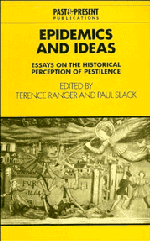Book contents
- Frontmatter
- Contents
- Contributors
- Preface
- 1 Introduction
- 2 Epidemic, ideas and classical Athenian society
- 3 Disease, dragons and saints: the management of epidemics in the Dark Ages
- 4 Epidemic disease in formal and popular thought in early Islamic Society
- 5 Plague and perceptions of the poor in early modern Italy
- 6 Dearth, dirt and fever epidemics: rewriting the history of British ‘public health’, 1780–1850
- 7 Epidemics and revolutions: cholera in nineteenth-century Europe
- 8 Hawaiian depopulation as a model for the Amerindian experience
- 9 Plague panic and epidemic politics in India, 1896–1914
- 10 Plagues of beasts and men; prophetic responses to epidemic in eastern and southern Africa
- 11 Syphilis in colonial East and Central Africa: the social construction of an epidemic
- 12 The early years of AIDS in the United Kingdom 1981–6: historical perspectives
- Index
- Past and Present Publications
6 - Dearth, dirt and fever epidemics: rewriting the history of British ‘public health’, 1780–1850
Published online by Cambridge University Press: 05 August 2011
- Frontmatter
- Contents
- Contributors
- Preface
- 1 Introduction
- 2 Epidemic, ideas and classical Athenian society
- 3 Disease, dragons and saints: the management of epidemics in the Dark Ages
- 4 Epidemic disease in formal and popular thought in early Islamic Society
- 5 Plague and perceptions of the poor in early modern Italy
- 6 Dearth, dirt and fever epidemics: rewriting the history of British ‘public health’, 1780–1850
- 7 Epidemics and revolutions: cholera in nineteenth-century Europe
- 8 Hawaiian depopulation as a model for the Amerindian experience
- 9 Plague panic and epidemic politics in India, 1896–1914
- 10 Plagues of beasts and men; prophetic responses to epidemic in eastern and southern Africa
- 11 Syphilis in colonial East and Central Africa: the social construction of an epidemic
- 12 The early years of AIDS in the United Kingdom 1981–6: historical perspectives
- Index
- Past and Present Publications
Summary
TWO VIEWS OF PUBLIC HEALTH
What you see depends on where you look and on what you are looking for. So historians maintain when analysing the beliefs and actions of previous generations, whether in matters of health and disease or in other aspects of social life. But, of course, the same point can be made about historians themselves. Their conclusions also depend heavily on the sites they have chosen for study, on the time-frames used and on the ways in which the range of subject matter has been limited. There can be no general remedy, for no one can write about everything. We can only try new ways of cutting across our material, so producing new perspectives which may serve new purposes.
In this chapter I want to suggest a range of new perspectives, not just by drawing attention to some little-studied areas, but by drawing together a series of historical discourses which are usually conducted separately. The results can only be suggestive and tentative, but they may be helpful for readers who wish to take a broad view of medicine in Britain in the decades of the industrial revolution, and who may be wondering how certain kinds of historiography are supposed to hang together. We can begin with two views of ‘public health’.
I shall discuss first the model which was used by Edwin Chadwick and other ‘ultra-sanitarians’ in the 1840s, and which is familiar from popular histories.
- Type
- Chapter
- Information
- Epidemics and IdeasEssays on the Historical Perception of Pestilence, pp. 125 - 148Publisher: Cambridge University PressPrint publication year: 1992
- 17
- Cited by

